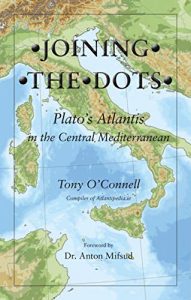Theophrastus
Italy
Italy seems to have an uncertain etymology; Thucydides claims that Italos, the Sicilian king gave his name to Italy, while more recently Emilio Spedicato(h) considers that ”the best derivation we believe to be the one proposed by the Italian nuclear engineer Felice Vinci (1998), in his monograph claiming a Baltic setting for the Homeric epic: he derives Italia from the rare Greek word aithalia, meaning the smoking one.” This is thought to be a reference to Italy’s many volcanoes.
Italy today is comprised of territory south of the Alps on mainland Europe including a very large boot-shaped peninsula, plus Sicily, Sardinia and some smaller island groups, which along with the French island of Corsica virtually enclose the Tyrrhenian Sea.
The earliest proposal that Italy could be linked with Atlantis came from Angelo Mazzoldi in 1840 when he claimed that before Etruria, Italy had been home to Atlantis and dated its demise to 1986 BC. Mazzoldi expressed a form of hyperdiffusion that had his Italian Atlantis as the mother culture which seeded the great civilisations of the eastern Mediterranean region(b).
Some of Mazzoldi’s views regarding ancient Italy were expanded on by later scholars such as Camillo Ravioli, Ciro Nispi-Landi, Evelino Leonardi, Costantine Cattoi, Guido DiNardo and Giuseppe Brex. Ravioli sought to associate the Maltese island of Gozo with his proposed Atlantis in Italy.
The Italian region of Lazio, which includes Rome, has had a number of very ancient structures proposed as Atlantean; Monte Circeo (Leonardi) and Arpino(a) (Cassaro). Another aspect of Italian prehistory is the story of Tirrenide, which was described as a westward extension of the Italian landmass into the Tyrrhenian Sea during the last Ice Age, with a land bridge to a conjoined Sardinia and Corsica. At the same time, there were land links to Sicily and Malta, which were all destroyed as deglaciation took place and sea levels rose.
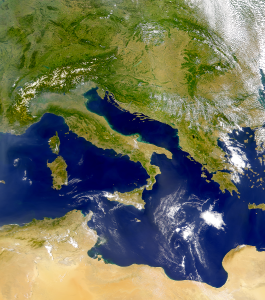 It is surprising that so few researchers have commented on Italy’s part in Plato’s Atlantis narrative considering that he twice, without any ambiguity, informs us that the Atlantean domain extended as far as Tyrrhenia (modern Tuscany).
It is surprising that so few researchers have commented on Italy’s part in Plato’s Atlantis narrative considering that he twice, without any ambiguity, informs us that the Atlantean domain extended as far as Tyrrhenia (modern Tuscany).
Crit.114c. So all these, themselves and their descendants dwelt for many generations bearing rule over many other islands throughout the sea and holding sway besides, as was previously stated, over the Mediterranean peoples as far as Egypt and Tuscany. Tim.25a/b. Now in this island of Atlantis there existed a confederation of kings, of great and marvellous power, which held sway over all the island, and over many other islands also and parts of the continent; and, moreover, of the lands here within the Straits they ruled over Libya as far as Egypt, and over Europe as far as Tuscany. (Bury)
The quotation from Timaeus is most interesting because of its reference to a ‘continent’. Some have understandably but incorrectly claimed that this is a reference to America or Antarctica, when quite clearly it refers to southern Italy as part of the continent of Europe. Moreover, Herodotus is quite clear (4.42) that the ancient Greeks knew of only three continents, Europe, Asia and Libya.
Philo of Alexandria (20 BC-50 AD) in his On the Eternity of the World(g) wrote “Are you ignorant of the celebrated account which is given of that most sacred Sicilian strait, which in old times joined Sicily to the continent of Italy?” (v.139).>The name ‘Italy’ was normally used until the third century BC to describe just the southern part of the peninsula(e).<Some commentators think that Philo was quoting Theophrastus, Aristotle’s successor. This would push the custom of referring to Italy as a ‘continent’ back near to the time of Plato. More recently, Armin Wolf, the German historian, when writing about Scheria relates(f) that “Even today, when people from Sicily go to Calabria (southern Italy) they say they are going to the ‘continente’.” This continuing usage is further confirmed by a current travel site(d) and by author, Robert Fox[1168.141]. I suggest that Plato used the term in a similar fashion and can be seen as offering the most rational explanation for the use of the word ‘continent’ in Timaeus 25a.
When you consider that close to Italy are located the large islands of Sicily, Sardinia and Corsica, as well as smaller archipelagos such as the Egadi, Lipari and Maltese groups, the idea of Atlantis in the Central Mediterranean can be seen as highly compatible with Plato’s description.
If we accept that Plato stated unambiguously that the domain of Atlantis included at least part of southern Italy and also declared that Atlantis attacked from beyond the Pillars of Heracles, then this appellation could not be applied at that time to any location in the vicinity of the Strait of Gibraltar but must have been further east, probably not too far from Atlantean Italy. This matches earlier alternative locations recorded by classical writers who placed the ‘Pillars’ at the straits of Messina or Sicily. I personally favour Messina, unless there is stronger evidence that some of the islands in or near the Strait of Sicily such as the Maltese or Pelagian Islands or Pantelleria were home to the ‘Pillars’.
(a) http://www.richardcassaro.com/hidden-italy-the-forbidden-cyclopean-ruins-of-giants-from-atlantis
(b) Archive 2509P (Eng) Archive 2943 (Ital)
(c) Archive 2946
(d) Four Ways to Do Sicily – Articles – Departures (archive.org)
(e) https://profilbaru.com/article/Name_of_Italy *
(f) Wayback Machine (archive.org)
(g) http://www.earlychristianwritings.com/yonge/book35.html
(h) http://2010-q-conference.com/ophir/ophir-27-10-09.pdf
Magna Graecia *
Magna Graecia is the term applied to those parts of southern Italy and 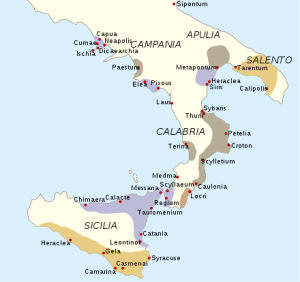 Sicily that were colonised by the Greeks, beginning as early as the 8th century BC. An interesting fact is that Philo of Alexandria (20 BC-50 AD) in his On the Eternity of the World(b) wrote “Are you ignorant of the celebrated account which is given of that most sacred Sicilian strait, which in old times joined Sicily to the continent of Italy?” (v.139). The name ‘Italy’ was normally used in ancient times to describe the southern part of the peninsula(d). Some commentators think that Philo was quoting Theophrastus, Aristotle’s successor. This would push the custom of referring to Italy as a ‘continent’ back to the time of Plato. More recently, Armin Wolf (1935- ), the German historian, when writing about Scheria relates(a) that “Even today, when people from Sicily go to Calabria (southern Italy) they say they are going to the “continente.” This continuing usage is confirmed by a current travel site(c). I suggest that Plato used the term in a similar fashion and can be seen as offering a more rational explanation for the use of the word ‘continent’ in Timaeus 25a, adding to the idea of Atlantis in the Central Mediterranean.
Sicily that were colonised by the Greeks, beginning as early as the 8th century BC. An interesting fact is that Philo of Alexandria (20 BC-50 AD) in his On the Eternity of the World(b) wrote “Are you ignorant of the celebrated account which is given of that most sacred Sicilian strait, which in old times joined Sicily to the continent of Italy?” (v.139). The name ‘Italy’ was normally used in ancient times to describe the southern part of the peninsula(d). Some commentators think that Philo was quoting Theophrastus, Aristotle’s successor. This would push the custom of referring to Italy as a ‘continent’ back to the time of Plato. More recently, Armin Wolf (1935- ), the German historian, when writing about Scheria relates(a) that “Even today, when people from Sicily go to Calabria (southern Italy) they say they are going to the “continente.” This continuing usage is confirmed by a current travel site(c). I suggest that Plato used the term in a similar fashion and can be seen as offering a more rational explanation for the use of the word ‘continent’ in Timaeus 25a, adding to the idea of Atlantis in the Central Mediterranean.
Giuseppe Palermo in his 2012 book Atlantide degli italiani is now bravely promoting the idea that Plato’s Atlantis was originally located beneath the town of Acri and the surrounding region of Calabria. He supports his claim by matching measurements provided by Plato with physical features around Acri(e). However surprising this idea may seem, it should be pointed out that according to Plato, Atlanteans had occupied southern Italy as far north as Tyrrhenia (Timaeus 25b & Critias 114c). If all this is not true, as a second prize, Acri can at least claim to be the birthplace of the famous American bodybuilder, Charles Atlas!
The Greeks began their gradual expansion westward between the 9th and 6th centuries BC, a development clearly illustrated on an excellent series of online maps(h). Understandably, they would have taken the shortest route from the Greek mainland to the heel of Italy and later on to Sicily. As they progressed with their colonisation new limits were set, and in time, exceeded. I suggest that these limits were each in turn designated the ‘Pillars of Heracles’ as they expanded. I speculate that Capo Colonna (Cape of the Column) in Calabria may have been one of those boundaries. Interestingly, 18th-century maps show up to five islands near the cape that are no longer visible(g), suggesting the possibility that in ancient times they could have been even more extensive, creating a strait that might have matched Plato’s description. On the other hand, the Strait of Messina was one of the locations recorded as the site of the ‘Pillars’ and considering that mariners at that time preferred to hug the coast, I would opt for the Strait of Messina rather than the more frequently proposed Strait of Sicily. A strait is defined as a narrow sea passage, a description that seems inappropriate for the 96 miles that separate Sicily from Tunisia.
For a brief history of the rise and fall of Magna Graecia, have a look at the classical wisdom website(f).
It is also noteworthy that there are a number of towns in Calabria where ancient Greek is still spoken(i). Similarly, back on the Peloponnese, the language of Sparta, Tsakonika, is still spoken by about 2,000 people in an area limited to 13 towns, villages and hamlets located around the village of Pera Melana(j).
(a) Wayback Machine (archive.org)
(b) http://www.earlychristianwritings.com/yonge/book35.html
(c) Four Ways to Do Sicily – Articles – Departures (archive.org)
(d) https://profilbaru.com/article/Name_of_Italy *
(e) https://www.atlantid.info/?page_id=539
(f) See: https://web.archive.org/web/20180824200049/https://classicalwisdom.com/magna-graecia-greater-greece/
(g) https://www.academia.edu/1152285/Discovery_of_Ancient_Harbour_Structures_in_Calabria_Italy_and_Implications_for_the_Interpretation_of_Nearby_Sites
(h) See: https://web.archive.org/web/20141105204103/https://learningobjects.wesleyan.edu/greek_colonies/
(i) http://www.madeinsouthitalytoday.com/mysterios-places.php
(j) BBC – Travel – The last speakers of ancient Sparta
Theophrastus
Theophrastus (372–287 BC) was a student of Aristotle, whom he eventually succeeded at the Lyceum, 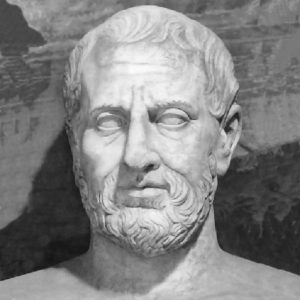 the home of the Peripatetic school of philosophy,*which he headed for thirty-six years. Eventually, he was succeeded by Strato of Lampsacus.*
the home of the Peripatetic school of philosophy,*which he headed for thirty-six years. Eventually, he was succeeded by Strato of Lampsacus.*
Theophrastus is frequently quoted as referring to Atlantis having colonies in the ‘sea’. Philo of Alexandria in his De Aeternitate Mindi[1423] has cited Theophrastus’ belief in the reality of Atlantis. Thorwald C. Franke expands on this in Appendix F of his Aristotle and Atlantis[880].
Theophrastus is sometimes referred to as the ‘father of botany’ and was one of the earliest writers to note that trees gained an extra outer layer each year. However, it would take over two thousand years before this fact led to the development of today’s invaluable science of dendrochronology.
Strait of Sicily
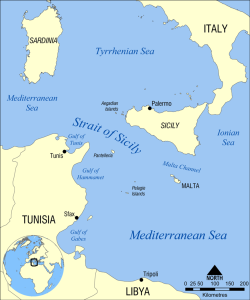 The Strait of Sicily is the name given to the extensive stretch of water between Sicily and Tunisia. Depending on the degree to which glaciation lowered the world’s sea levels during the last Ice Age; three views have emerged relating its possible effect on Sicily during that period:
The Strait of Sicily is the name given to the extensive stretch of water between Sicily and Tunisia. Depending on the degree to which glaciation lowered the world’s sea levels during the last Ice Age; three views have emerged relating its possible effect on Sicily during that period:
(i) Both the Strait of Messina to the north, between Sicily and Italy together with the Strait of Sicily to the south remained open.
(ii) The Strait of Messina was closed, joining Sicily to Italy, while the Strait of Sicily remained open.
(iii) Both the Strait of Messina and the Strait of Sicily were closed, providing a land bridge between Tunisia and Italy, separating the Eastern from the Western Mediterranean Basins.
I find it strange that what we call today the Strait of Sicily is 90 miles wide. Now the definition of ‘strait’ is a narrow passage of water connecting two large bodies of water. How 90 miles can be described as ‘narrow’ eludes me. Is it possible that we are dealing with a case of mistaken identity and that the ‘Strait of Sicily’ is in fact the Strait of Messina, which is narrow? Philo of Alexandria (20 BC-50 AD) in his On the Eternity of the World(a) wrote “Are you ignorant of the celebrated account which is given of that most sacred Sicilian strait, which in old times joined Sicily to the continent of Italy?” (v.139). Some commentators think that Philo was quoting Theophrastus, Aristotle’s successor. The name ‘Italy’ was normally used in ancient times to describe the southern part of the peninsula(b).
Armin Wolf, the German historian, noted(e) that “Even today, when people from Sicily go to Calabria (southern Italy) they say they are going to the “continente.” I suggest that Plato used the term in a similar fashion and was quite possibly referring to that same part of Italy which later became known as ‘Magna Graecia’. Robert Fox in The Inner Sea[1168.141] confirms that this long-standing usage of ‘continent’ refers to Italy.
It is worth pointing out that the Strait of Messina is sometimes referred to in ancient literature as the Pillars of Herakles and designates the sea west of this point as the ‘Atlantic Ocean’. Modern writers such as Sergio Frau and Eberhard Zangger, among others, have pointed out that the term ‘Pillars of Herakles’ was applied to more than one location in the Mediterranean in ancient times.
The Strait of Messina is frequently associated with the story of Scylla & Charybdis, which led Arthur R. Weir in a 1959 article(d) to refer to ancient documents, which state that Scylla & Charybdis lie between the Pillars of Heracles.
In 1910, the celebrated Maltese botanist, John Borg, proposed[1132] that Atlantis had been situated on what is now submerged land between Malta and North Africa. A number of other researchers, such as Axel Hausmann and Alberto Arecchi, have expressed similar ideas.
The Strait of Sicily is home to a number of sunken banks, previously exposed during the Last Ice Age. As levels rose most of these disappeared, an event observed by the inhabitants of the region at that time. The MapMistress website(c) has proposed that one of these banks was the legendary Erytheia, the sunken island of the far west. The ‘far west’ later became the Strait of Gibraltar but for the early Greeks it was the Central Mediterranean.
(a) https://web.archive.org/web/20200726123301/http://www.earlychristianwritings.com/yonge/book35.html
(d) Atlantis – A New Theory, Science Fantasy #35, June 1959 pp 89-96 https://drive.google.com/file/d/10JTH401O_ew1fs8uhXR9C5IjNDvqnmft/view
>(e) Wayback Machine (archive.org) See Note 5<
Continent *
The term ‘Continent’, is derived from the Latin terra continens, meaning ‘continuous land’ and in English is relatively new, not coming into use until the Middle English period (11th-16th centuries). Apart from that, it is sometimes used to imply the mainland. The Scottish island of Shetland is known by the smaller islands in the archipelago as Mainland, its old Norse name was Megenland, which means mainland. In turn, the people of Mainland, Shetland, will apply the same title to Britain, who in turn apply the term ‘continuous land’ or continent to mainland Europe. It seems that the term is relative.
The term has been applied arbitrarily by some commentators to Plato’s Atlantis, usually by those locating it in the Atlantic. Plato never called Atlantis a continent, but instead, as the sixteen instances below prove, he consistently referred to it as an island, probably the one containing the capital city of the confederation or alliance!
[Timaeus 24e, 25a, 25d Critias 108e, 113c, 113d, 113e, 114a, 114b, 114e, 115b, 115e, 116a, 117c, 118b, 119c]
Several commentators have assumed that when Plato referred to an ‘opposite continent’ he was referring to the Americas, however, Herodotus, who flourished after Solon and before Plato, was quite clear that there were only three continents known to the Greeks, Europe, Asia and Libya (4.42). In fact, before Herodotus, only two landmasses were considered continents, Europe and Asia, with Libya sometimes considered part of Asia. Furthermore, Anaximander drew a ‘map’ of the known world (left), a century after Herodotus, showing only the three continents, without any hint of territory beyond them.
Nevertheless, there has always been a school of thought that supported the idea of the ancient Greeks having knowledge of the Americas. In 1900, Peter de Roo in History of America before Columbus [890] not only supported this contention but suggested further that ancient travellers from America had travelled to Europe [Vol.1.Chap 5].
Daniela Dueck in her Geography in Classical Antiquity [1749] noted that “Hecataeus of Miletus divided his periodos gês into two books,each devoted to one continent, Europe and Asia, and appended his description of Egypt to the book on Asia. In his time (late sixth century bce), there was accordingly still no defined identity for the third continent. But in the fifth century the three continents were generally recognized, and it became common for geographical compositions in both prose and poetry to devote separate literary units to each continent.”
So when Plato does use the word ‘continent’ [Tim. 24e, 25a, Crit. 111a] we can reasonably conclude that he was referring to one of these landmasses, and more than likely to either Europe or Libya (North Africa) as Atlantis was in the west, ruling out Asia.
Philo of Alexandria (20 BC-50 AD) in his On the Eternity of the World(b) wrote “Are you ignorant of the celebrated account which is given of that most sacred Sicilian strait, which in old times joined Sicily to the continent of Italy?” (v.139). It would seem that in this particular circumstance the term ‘Sicilian Strait’ refers to the Strait of Messina, which is another example of how ancient geographical terms often changed their meaning over time (see Atlantic & Pillars of Herakles).
The name ‘Italy’ was normally used in ancient times to describe the southern part of the peninsula(d). Some commentators think that Philo was quoting Theophrastus, Aristotle’s successor. This would push the custom of referring to Italy as a ‘continent’ back to the time of Plato, who clearly states (Tim. 25a) that the Atlantean alliance “ruled over all the island, over many other islands as well. and over sections of the continent.” (Wells). The next passage recounts their control of territory in Europe and North Africa, so it naturally begs the question as to what was ‘the continent’ referred to previously? I suggest that the context had a specific meaning, which, in the absence of any other candidate and the persistent usage over the following two millennia can be reasonably assumed to have been southern Italy.
Centuries later, the historian, Edward Gibbon (1737-1794) refers at least twice[1523.6.209/10] to the ‘continent of Italy’. More recently, Armin Wolf (1935- ), the German historian, when writing about Scheria relates(a) that “Even today, when people from Sicily go to Calabria (southern Italy) they say they are going to the “continente.” This continuing usage of the term is confirmed by a current travel site(c) and by author, Robert Fox in The Inner Sea [1168.141].
I suggest that Plato similarly used the term and can be seen as offering a more rational explanation for the use of the word ‘continent’ in Timaeus 25a, adding to the idea of Atlantis in the Central Mediterranean.
Giovanni Ugas claims that the Mediterranean coast of southern Spain and France, along with the Italian peninsula constituted the ‘true continent’ (continente vero) referred to by Plato. (see below)
Furthermore, the text informs us that this opposite continent surrounds or encompasses the true ocean, a description that could not be applied to either of the Americas as neither encompasses the Atlantic, which makes any theory of an American Atlantis more than questionable.
Modern geology has definitively demonstrated that no continental mass lies in the Atlantic and quite clearly the Mediterranean does not have room for a sunken continent.
(a) Wayback Machine (archive.org)
(b) https://web.archive.org/web/20200726123301/http://www.earlychristianwritings.com/yonge/book35.html
(c) Four Ways to Do Sicily – Articles – Departures (archive.org)
(e) The Elusive Location of Atlantis Part 1 – Luciana Cavallaro (archive.org) *
Philo of Alexandria
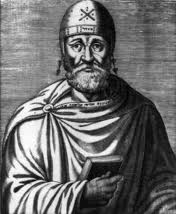 Philo of Alexandria (20 BC-50 AD) also known as Philo the Jew, was a philosopher based in Alexandria. He was a firm supporter of the reality of Atlantis’ existence. He wrote on the subject in his De Aeternitate Mundi (On the Eternity of the Earth) [1423.v.141]+ where he is thought by some to be quoting Theophrastus(a), Aristotle’s successor. This view is held by Thorwald C. Franke [0880.131] and J. V. Luce in Atlantis: Fact or Fiction [0522.51].
Philo of Alexandria (20 BC-50 AD) also known as Philo the Jew, was a philosopher based in Alexandria. He was a firm supporter of the reality of Atlantis’ existence. He wrote on the subject in his De Aeternitate Mundi (On the Eternity of the Earth) [1423.v.141]+ where he is thought by some to be quoting Theophrastus(a), Aristotle’s successor. This view is held by Thorwald C. Franke [0880.131] and J. V. Luce in Atlantis: Fact or Fiction [0522.51].
It is interesting that from around 330 BC and for nearly a thousand years(b) the Strait of Messina was known as Fretum Siculum, which translates as the Sicilian Strait, prompting Philo to write “Are you ignorant of the celebrated account which is given of that most sacred Sicilian strait, which in old times joined Sicily to the continent of Italy?” [v.139].
Note how Philo refers to Italy as a continent.
[1423.v.141]+ https://archive.org/details/deaeternitatemu00philgoog *
Shoals of Mud
A Shoal of mud is stated by Plato (Tim.25d) to mark the location of where Atlantis ‘settled’. He described these shallows in the present tense, clearly implying that they were still a maritime hindrance even in Plato’s day.
Three of the most popular translations clearly indicate this:
….the sea in those parts is impassable and impenetrable because there is a shoal of mud in the way; and this was caused by the subsidence of the island.
…..the ocean at that spot has now become impassable and unsearchable, being blocked up by the shoal of mud which the island created as it settled down.”
…..the sea in that area is to this day impassible to navigation, which is hindered by mud just below the surface, the remains of the sunken island.
Wikipedia has noted(h) that “during the early first century, the Hellenistic Jewish philosopher Philo wrote about the destruction of Atlantis in his On the Eternity of the World, xxvi. 141, in a longer passage allegedly citing Aristotle’s successor Theophrastus.
‘ And the island of Atalantes [translator’s spelling; original: “????????”] which was greater than Africa and Asia, as Plato says in the Timaeus, in one day and night was overwhelmed beneath the sea in consequence of an extraordinary earthquake and inundation and suddenly disappeared, becoming sea, not indeed navigable, but full of gulfs and eddies’.”
Since it is probable that Atlantis was destroyed around a thousand years or more before Solon’s Egyptian sojourn, to have continued as a hazard for such a period suggests a location that was little affected by currents or tides. The latter would seem to offer support for a Mediterranean Atlantis as that sea enjoys negligible tidal changes, as can be seen from the chart below. The darkest shade of blue indicates the areas of minimal tidal effect.
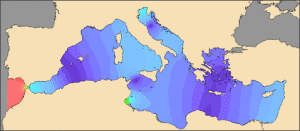 If Plato was correct in stating that Atlantis was submerged in a single day and that it was still close to the water’s surface in his own day, its destruction must have taken place a relatively short time before since the slowly rising sea levels would eventually have deepened the waters covering the remains of Atlantis to the point where they would not pose any danger to shipping. The triremes of Plato’s time had an estimated draught of about a metre so the shallows must have had a depth that was less than that.
If Plato was correct in stating that Atlantis was submerged in a single day and that it was still close to the water’s surface in his own day, its destruction must have taken place a relatively short time before since the slowly rising sea levels would eventually have deepened the waters covering the remains of Atlantis to the point where they would not pose any danger to shipping. The triremes of Plato’s time had an estimated draught of about a metre so the shallows must have had a depth that was less than that.
The reference to mud shoals resulting from an earthquake brings to mind the possibility of liquefaction. This is perhaps what happened to the two submerged ancient cities close to modern Alexandria. Their remains lie nine metres under the surface of the Mediterranean.
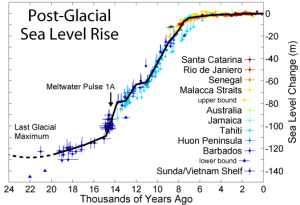 Our knowledge of sea-level changes over the past two and a half millennia should enable us to roughly estimate all possible locations in the Mediterranean where the depth of water of any submerged remains would have been a metre or less in the time of Plato.
Our knowledge of sea-level changes over the past two and a half millennia should enable us to roughly estimate all possible locations in the Mediterranean where the depth of water of any submerged remains would have been a metre or less in the time of Plato.
Some supporters of a Black Sea Atlantis have suggested the shallow Strait of Kerch between Crimea and Russia as the location of Plato’s ‘shoals’(e) .
The tidal map above offers two areas west of Athens and Egypt that do appear to be credible location regions, namely, (1) from the Balearic Islands, south to North Africa and (2), a more credible straddling the Strait of Sicily. This region offers additional features, making it much more compatible with Plato’s account.
By contrast, just over a hundred miles south of that Strait, lies the Gulf of Gabés, which boasts the greatest tidal range (max 8 ft) within the Mediterranean.
The Gulf of Gabes formerly known as Syrtis Minor and the larger Gulf of Sidra to the east, previously known as Syrtis Major, was greatly feared by ancient mariners and continue to be very dangerous today because of the shifting sandbanks created by tides in the area.
There are two principal ancient texts that possibly support the gulfs of Syrtis as the location of Plato’s ‘shoal’. The first is from Apollonius of Rhodes who was a 3rd-century BC librarian at Alexandria. In his Argonautica (Bk IV ii 1228-1250)(a) he unequivocally speaks of the dangerous shoals in the Gulf of Syrtis. The second source is the Acts of the Apostles (Acts 27 13-18) written three centuries later, which describes how St. Paul on his way to Rome was blown off course and feared that they would run aground on “Syrtis sands.” However, good fortune was with them and after fourteen days they landed on Malta. The Maltese claim regarding St. Paul is rivalled by that of the Croatian island of Mljet as well Argostoli on the Greek island of Cephalonia. Even more radical is the convincing evidence offered by Kenneth Humphreys to demonstrate that the Pauline story is an invention(b).
Both the Strait of Sicily and the Gulf of Gabes have been included in a number of Atlantis theories. The Strait and the Gulf were seen as part of a larger landmass that included Sicily according to Butavand, Arecchi and Sarantitis who named the Gulf of Gabes as the location of the Pillars of Heracles. Many commentators such as Frau, Rapisarda and Lilliu have designated the Strait of Sicily as the ‘Pillars’, while in the centre of the Strait we have Malta with its own Atlantis claims.
Zhirov[458.25] tried to explain away the ‘shoals’ as just pumice stone, frequently found in large quantities after volcanic eruptions. However, Plato records an earthquake, not an eruption and Zhirov did not explain how the pumice stone was still a hazard many hundreds of years after the event. Although pumice can float for years, it will eventually sink(c). It was reported that pumice rafts associated with the 1883 eruption of Krakatoa were found floating up to 20 years after that event. Zhirov’s theory does not hold water (no pun intended) apart from which, Atlantis was destroyed as a result of an earthquake. not a volcanic eruption and I think that the shoals described by Plato were more likely to have been created by liquefaction and could not have endured for centuries.
Nevertheless, a lengthy 2020 paper(d) by Ulrich Johann offers additional information about pumice and in a surprising conclusion proposes that it was pumice rafts that inspired Plato’s reference to shoals!
Andrew Collins in an effort to justify his Cuban location for Atlantis needed to find Plato’s ‘shoals of mud’ in the Atlantic and for me, in what seems to have been an act of desperation he decided that the Sargasso Sea fitted the bill [072.42]. Similarly, Emilio Spedicato in support of a Hispaniola Atlantis also opted for the Sargasso. However, neither Collins or Spedicato were the first to make this suggestion. Chedomille Mijatovich (1842-1932), a Serbian politician, economist and historian was one of the first in modern times to suggest that the Sargasso Sea may have been the maritime hazard described by Plato as a ‘shoal of mud’, which resulted from the submergence of Atlantis. However, neither explains how anyone can mistake seaweed for mud!
The late Andis Kaulins believed that Atlantis did exist and considered two possible regions for its location; the Minoan island of Thera or some part of the North Sea that was submerged at the end of the last Ice Age when the sea levels rose dramatically. Kaulins noted that part of the North Sea is known locally as ‘Wattenmeer’ or Sea of Mud’ reminiscent of Plato’s description of the region where Atlantis was submerged, after that event.
An even more absurd suggestion came from the American scholar William Arthur Heidel (1868-1941), who denied the reality of Atlantis and wrote a critical paper [0374] on the subject (republished July 2013(g)). He claimed that an expeditionary naval force sent by Darius in 515 BC under Scylax of Caryanda to explore the Indus River, eventually encountered waters too shallow for his ships, and that this was the inspiration behind Plato’s tale of unnavigable seas. Heidel further claimed that Plato’s battle between Atlantis and Athens is a distorted account of the war of invasion between the Persians and the peoples of the Indus Valley (Now Pakistan)!
(a) https://www.sacred-texts.com/cla/argo/argo53.htm
(b) The Curious Yarn of Paul’s “Shipwreck” (archive.org) *
(c) https://www.sciencedaily.com/releases/2017/05/170523144110.htm
(e) Index (atlantis-today.com)
(f) https://www.abovetopsecret.com/forum/thread61382/pg1
(g) A Suggestion concerning Plato’s Atlantis on JSTOR (archive.org)
(h) Atlantis – Wikipedia_?s=books&ie=UTF&qid=1376067567&sr=-
